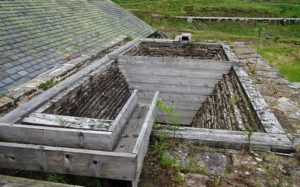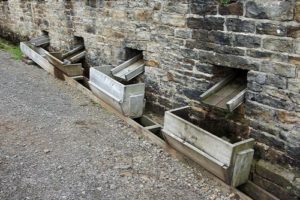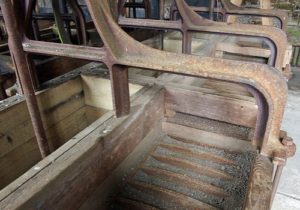This is a lovely site at the top of Weardale surrounded by wild flower meadows. There used to be a lot of mature coniferous plantations but a lot of trees were blown down in gales earlier this year. Much of the plantations have been felled and the woodland walks around the site are currently closed off.
This used to be a major lead mining area in the C19th and the site of the former Park Level Mine has been restored to show what a C19th lead mine was like. There is a need to learn a whole new vocabulary during the visit with buddles and crushers, trommels and jiggers as well as washing and settling floors and the mineshop. There is also chance to do an underground tour of the mine.
Lead occurs in vertical veins in this part of Weardale, which were originally dug out where they reached the surface. Veins were often exposed by damning water and then releasing it in a flood to wash away the covering earth and rocks. This left great scars in the landscape called hushes. An excellent example can be seen along the unclassified road that runs between Nenthead a few miles further up the valley and Garrigill.
Mining began on this site in 1853 by William Blackett Mining who leased the mineral rights from the Bishop of Durham. They began driving the Park Level Mine to intersect eleven mineral veins. It soon became one of the richest mines in the country. Surface buildings included the mineshop where miners lived during the week. Storage bays (bousesteads) were built to store the lead ore (bouse) from the mine. The washing floors separated the lead ore from waste material and the settling tanks allowed all the tiny fragments of lead to be collected. At first this was done by hand but later this was done mechanically by jiggers and the large classifier with the particles of lead ore eventually being collected by the Buddles.
The lead mine had only been working a few years when the price of lead plummeted making it uneconomic to work. The mine closed but was later taken over by Weardale Lead and continued to work until 1910. It did reopen briefly during 1916 but soon closed and hasn’t been worked since. Many of the families were forced to emigrate through poverty and unemployment to the States, Canada, New Zealand, Australia and Alaska.
The site is now owned by Durham County Council and the different buildings are gradually being restored. It is one of the most complete lead mining sites in Britain. Part of the mine is open for guided visits and is an informative and interesting trip. There are some rather basic information signs around the site.
There is a small exhibition area in the Visitor Centre with examples of minerals, some of the games played by the miners and a lovely display of spar boxes made by them in their spare time. These contain displays of different minerals often arranged to form scenes.
Out on the site, the first building is the MINESHOP. Men and boys worked in the mine to supplement farming income, leaving the wives and girls to work the farms. Farms were scattered and the miners had to walk long distances to reach the mine. Once the mineshop was built, miners could live here during the week, just going home for weekends. On the ground floor are the stables and smithy. Horses were essential for getting the ore out of the mine and were well looked after.
On the top floor was the office with safe, desk, shelves for ledgers and a cupboard for storing maps. The small room next to it was probably used as a store room for gunpowder and candles and now has some useful information boards about lead mining. It is worth spending time reading these to get an understanding of how the site worked.
The other room was used by the miners and had eight bunk beds. Miners slept four to a bunk and the young boys slept across the bottom of the beds. The straw mattresses were replaced every six months. Belongings and food bags were hung from pegs or slung over the rafters. A small peat fire provided heat as well as being used for cooking. The miners brought provisions to last for the week .
Lead ore in the form of galena, was brought out of the mine and stored in bank of BOUSESTEADS along the side of the washing floor. Each partnership team of miners had his own stead. The ore bearing rocks contain a lot of waste material which had to be removed. Originally the ore was crushed by hand, washed on the washing floor and the galena collected in the settling tanks. This was hard and slow work done by young boys. Also, it did not recover all of the galena.
Once the large WATERWHEEL was built in 1877, a lot of this work could now be done mechanically. Water was collected along miles of ditches and aqueducts to work the wheel which was used to crush and separate the ore.
Next to the wheel is the CRUSHER. Wagons of ore were pulled up an incline and tipped into rollers which crushed the large lumps of ore into pieces the size of walnuts. From here it passed through a series of rotary sieves, TROMMELS, which graded the fragments by size. The crushed ore was taken to the JIGGER HOUSE where the task of separating the heavier ore from the lighter waste rock began. The crushed ore was put into large wooden tanks and pistons, driven by the waterwheel, moved up and down gradually separating the galena from the waste rock. The speed of the pistons depended on the size of material.
Galena being heavier settles to the bottom of the jiggers. The waste material and water washed out of the top, drained away and was taken to the BUDDLE HOUSE where galena particles as small as grains of sand could be recovered from the waste. The sediment from the jiggers passed to the LARGE CLASSIFIER where it flowed into an inverted pyramid. Again the solid material was agitated. Lighter waste flowed away leaving the heavier ore rich material at the bottom.
The ore rich sludge was taken to the BRUNTON BUDDLES, where a smaller waterwheel worked a continuous canvas belt. The ore rich oil was poured onto the belt and sprayed with water. As the belt traveled upwards, the lighter material was washed off leaving the galena to be taken to the top and tipped into a tank underneath.
The waste, known as the DEADS, was collected and tipped off the wagon way at the end of the bousesteads. As methods of extraction improved, the earlier deads were reworked to extract more of the ore.
The ore wasn’t smelted on site but was taken to a loading dock, the BINGSTEAD, where it was taken by horse and cart to Allendale for smelting.
This is a fascinating site but is quite difficult to understand. Apart from those on the upper floor of the mineshop, signs around the site are very superficial and we would have liked more detailed information about how the site worked. At the end of the visit we were still unsure what some things were and what they did. The web site has little information either.
We felt it would be useful to have a set trail around the site presenting the site in a logical sequence explaining how the lead was mined and ore extracted with much more detailed information boards. Staff do have a lot of information and are happy to talk and answer questions.
There is little information about the life and conditions of the miners, although some of this is covered during the mine tour. This is excellent but involves nearly an hour underground often wading through several inches of running water. I have written a separate review covering this here.
For those not wanting to do the mine tour, there is little information about how the ore was mined. We felt tithes was a major omission.
There was a school party going round the site when we visited and it was interesting to listen to museum staff talking to the children. A lot of information coming out wasn’t available around the site.
One of the downsides of the school visit meant there were issues of taking pictures of areas when the children were around. They were working on the washing floor and we were asked to wait until they had gone before taking pictures.
So the site ranks as 5* and I have given this ranking on the report as it is a fantastic site and has a tremendous amount of potental. However, the information only rates 2* and a “could do better”. It is a good example of dumbing down to a point of becoming meaningless. There is a small shop with a good selection of local books. The cafe is excellent.
Allow yourself several hours to explore the site properly and do the underground mine tour.
DISABLED VISITORS
The site has been restored over the last 25 years by Durham County Council who have made great efforts to make the site as accessible to visitors as possible. Staff are very aware of problems faced by disabled visitors and go out of their way to be helpful. One member of staff can use sign language and they have information in large size print. There is an interpretive audio cassette for the exhibition area. There is a hearing induction loop in the Visitor Centre.
There is disabled parking by the entrance and a level entrance to and within the reception area with shop, cafe and exhibition area. There is a disabled toilet in the cafe and also on the site. There is mobility scooter which can be hired.
Paths around the site are gravel and well maintained. There is level access to the ground floor of all the buildings and ramped access to the first floor of the mineshop and also to the jiggers, buddles and large classifier. There are steps up to the waterwheel although this can easily be seen from a distance. There are steps up to the large classifier, so it is not possible to look into the inverted pyramid.
Wheelchair access to the mine would be difficult as the surface is very rough and uneven. If given advance warning, the museum can arrange for a member of staff to take people with limited mobility through the emergency exit into the mine. This avoids the walk through running water and the low roof. It also cuts down the length of time spent underground considerably.
Dogs are allowed round the site except the mine and cafe, but the restriction for the cafe does not apply to assistance dogs.
Disabled visitors get entry at the concessionary rate and carers are admitted free.










